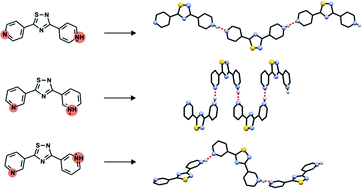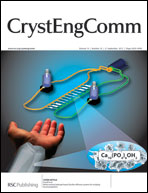The possibility of constructing extended networks based on NH+⋯N charge-assisted hydrogen bonding and N⋯I interactions was explored. The organic modules 3,5-di-(3-pyridyl)-1,2,4-thiadiazole (L1) and 3,5-di-(4-pyridyl)-1,2,4-thiadiazole (L2) possess two pyridyl groups, allowing them to act both as hydrogen-bond acceptors and hydrogen-bond donors with H+ acting as the main linker between the molecular units. The crystal structure of the ionic compounds (HL1)I3, (HL1)I5, (HL1)IBr2, (HL2)I3, and (HL2)IBr2 are described; the position of the nitrogen atoms in the outwards pyridyl rings in L1 and L2 leads to the formation of 1D helices of interacting cations (HL1)+ and zig-zag chains of interacting cations (HL2)+. In the case of (HL1)I5, cationic helices of (HL1)+ and helices of I5− take place in a highly shape-complementary arrangement. The crystal structure of the bis-adduct L1·2I2 features the presence of intermolecular iodine–iodine long contacts to form infinite I2 chains. A comparative structural analysis carried out using the XPac procedure identifies three common molecular arrangements and confirms the importance of directional interactions and molecular shape of the target molecules in directing the packing preferences of this family of structures.

You have access to this article
 Please wait while we load your content...
Something went wrong. Try again?
Please wait while we load your content...
Something went wrong. Try again?


 Please wait while we load your content...
Please wait while we load your content...